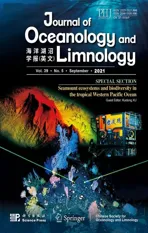Distinct BSRs and their implications for natural gas hydrate formation and distribution at the submarine Makran accretionary zone*
2021-10-12BinLIUWaseemHaiderSYEDJiangxinCHENXiguangDENGLiYANGLeonardoAZEVEDOMinliangDUANTingtingWUJinfengMAKeliangLI
Bin LIU ,Waseem Haider SYED ,Jiangxin CHEN ,Xiguang DENG ,Li YANG ,Leonardo AZEVEDO ,Minliang DUAN ,Tingting WU ,Jinfeng MA ,Keliang LI
1 Key Laboratory of Marine Mineral Resources, Ministry of Natural Resources, Guangzhou Marine Geological Survey,Guangzhou 510760, China
2 National Institute of Oceanography, Karachi 75600, Pakistan
3 Key Laboratory of Gas Hydrate, Ministry of Natural Resources, Qingdao Institute of Marine Geology, Qingdao 266071, China
4 Laboratory for Marine Mineral Resources, Pilot National Laboratory for Marine Science and Technology (Qingdao), Qingdao 266237, China
5 CERENA/Instituto Superior Técnico, Lisbon University, Lisbon 1049-001, Portugal
6 Key Lab of Submarine Geosciences and Prospecting Techniques, MOE and College of Marine Geosciences, Ocean University of China, Qingdao 266100, China
Abstract To investigate the nature of gas hydrates in the Makran area,new high-resolution geophysical data were acquired between 2018–2019.The data collected comprise multibeam and two-dimensional multi-channel seismic reflection data.The multibeam bathymetry data show East-North-East (ENE) ridges,piggy-back basins,canyon and channel systems,and the morphology of the abyssal plain.Continuous and discontinuous bottom simulating reflectors (BSRs) occur in the piggy-back basins on most of the seismic profiles available.The BSRs cut the dipping layers with strong amplitude and reversed polarity.Discontinuous BSRs indicate a transition along a dipping high-permeable sand layers from gas-rich segment to the gas hydrate-bearing segment and suggest alternating sediments of fine and relatively coarse grain size.Double BSRs are highly dynamic and attributed to slumps occurring in the study area.The BSRs induced by slumps are located both at deep and shallow depths,responding to the temperature or pressure variation.For the first time,BSRs are observed in the abyssal plain of the Makran area,being associated with anticline structures,which do not show large spatial continuity and are strongly conditioned by structural conditions such as anticlines and fluid migration pathways,including deep fault,gas chimney,and high-permeable sedimentary layer.Our results may help to assess the gas hydrate potential within the piggy-back basins and to determine the most promising target areas.Moreover,results about the abyssal plain BSR may help to locate hydrocarbon reservoirs in the deep ocean.
Keyword:gas hydrate-bearing sand-prone sediments;double bottom simulating reflector (BSR);multiple BSR;canyon channel system;abyssal plain
1 INTRODUCTION
Gas hydrate is an ice-like compound of water and gas (mainly methane) formed under low temperature and high-pressure conditions (Kvenvolden,1993).Gas hydrates occur widely in continental margins and in permafrost soils and are considered a potential energy resource (Kvenvolden,1993;Boswell and Collett,2011).Many countries such as US,Japan,Canada,China,and India,have launched national plans to investigate and assess the potential of gas hydrates as energy resource.It is believed that gas hydrates might play an important role as a bridging fuel during the energy transition from traditional sources (such as oil and coal) to greener energy sources.The presence of a bottom simulating reflector(BSR) on seismic profiles is the most important indicator of gas hydrates presence (Shipley et al.,1979;Hyndman and Spence,1992;Berndt et al.,2004;Petersen et al.,2007;Shedd et al.,2012),and marks the lower boundary of the gas hydrate stability zone,occurring approximately 500–800 m below the seafloor,depending on the water depth and the local geothermal gradient (Minshull and White,1989).
BSRs have been discovered in almost all the marine gas hydrate provinces.In most cases,only one strong and continuous BSR is observed on seismic profiles.However,BSRs may manifest as discontinuous and patchy reflections,such as those observed in the Gulf of Mexico (Shedd et al.,2012)and in the NanKai Trough (Tamaki et al.,2017).This type of BSR has been interpreted as the seismic response to a transition along a sediment layer from gas-rich to gas hydrate-bearing.
Multiple BSRs are another type of non-classical BSR observed in some sites worldwide such as at the Hydrate Ridge off shore Oregon,USA (Bangs et al.,2005),on the continental slope of the Nankai Trough off shore Japan (Foucher et al.,2002) and on the continental margin to the west of Norway (Posewang and Mienert,1999),in the western Ross Sea,Antarctica (Geletti and Busetti,2011),and in the Black Sea (Popescu et al.,2006;Zander et al.,2017).Multiple BSRs are interpreted as several similar BSRs with different amplitudes and depths.Many mechanisms have been proposed to explain the origin of multiple BSRs (Posewang and Mienert,1999;Foucher et al.,2002;Berndt et al.,2004;Popescu et al.,2006;Geletti and Busetti,2011;Tinivella and Giustiniani,2013),but the origin of the multiple BSR is still hotly debated.
Makran subduction zone,off shore Pakistan,is well known to host huge amounts of gas hydrates.The first evidences of high gas concentration in sediments were found during bright spot investigations in migrated seismic sections (White,1977).Methane anomalies were discovered in 1990s during the investigation of fluid seepage in water column,seeprelated chemo-synthetic clams,and authigenic carbonate precipitation (Von Rad et al.,1996,2000).The presence of gas hydrates was inferred from BSRs interpreted on existing seismic profiles (Minshull and White,1989;Minshull et al.,1992;Grevemeyer et al.,2000).Full waveform inversion of a region with a distinct BSR shown a thick layer of free gas existing beneath the BSRs due to gas hydrate dissociation(Sain et al.,2000).Wide-spread cold-seep structures,such as mud volcanos,pockmarks,and gas chimneys have been observed in Makran subduction zone (Von Rad et al.,2000;Wiedicke et al.,2001;Delisle et al.,2002;Delisle,2004;Kassi et al.,2014).However,previous geophysical studies are mainly based on low-frequency (~30 Hz) seismic data which aims to the deep oil and gas reservoir identification and characterization (Ding et al.,2010;Smith et al.,2012,2014).However,gas hydrates occur at shallower depths in the top few hundred meters below the seafloor and the seismic characteristics of gas hydratebearing sediment depend on the seismic frequency(Vanneste et al.,2001).High frequency (~65 Hz)seismic data can provide new insights into the nature and distribution of gas hydrates within sediments.
During the China-Pakistan joint marine scientific cruise in 2018–2019,new multibeam bathymetry data and high frequency two-dimensional seismic data(dominant frequency~65 Hz) were acquired,which offered a good chance to better characterize the distribution and nature of gas hydrate here.The multibeam bathymetry data provides detailed information about East-North-East (ENE) ridges,piggy-back basins,canyon and channel systems,and the abyssal plain.The new seismic profiles show the widespread presence of BSR in the investigated area,which have been identified in previous scientific cruises.Moreover,the new multi-channel seismic reflection profiles reveal some new features including(1) discontinuous and patch BSR,(2) double BSRs,and (3) BSRs in the abyssal plain.The aim of the work presented herein is to (1) report the distinct BSRs in the Makran area,(2) analysis their characteristics and (3) infer their origins and implications for gas hydrate distributions and associated dynamic processes.
2 GEOLOGICAL BACKGROUND
The study area is situated in the Makran subduction zone,off shore Pakistan,in the northern Arabian Sea(Fig.1a).The Makran continental margin is the submarine part of an accretionary wedge formed due to the subduction of the Arabian plate under the Eurasian plate at low angle between 2°and 8° (Schlüter et al.,2002).This is the largest wedge worldwide(Clift and Vannucchi,2004) and is about 400-km wide from north to south and 1 000-km long from east to west.The continuous input of erosive material from the Himalayas resulted in over 7-km thick sediments at the deformation front,forming the world’s most extensive accretionary prism (Golonka,2004).The movement rate of the Arabian plate is approximately 4 cm/a and increases from west to east (DeMets et al.,1990).The off shore part of the Makran accretionary wedge has a narrow shelf and a steep upper continental slope.The subduction continued from Cretaceous to the present (Kukowski et al.,2001).
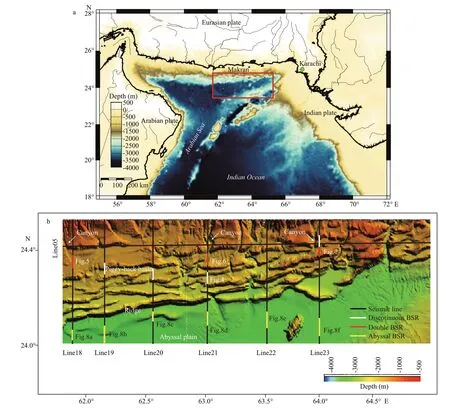
Fig.1 Location of the study area is delimited by the red polygon
The study area is characterized by a series of ridges and piggy-back basins (Fig.1b).Sediments within the piggy-back basins are sand-enriched layers (Fruehn et al.,1997).A series of nearly parallel thrust faults are distributed due to the south-north subduction(Hosseini et al.,2018).In the north,the thrust faults are located below undeformed sediments and are not active now.The activity of faults increases from the north to the south.At the southernmost end,a portion of the thrust fault is exposed to the seafloor.
The northern Arabian Sea is tectonically active and characterized by high biological productivity and high sedimentation rate (Minshull and White,1989;Von Rad et al.,2000;Bohrmann et al.,2008).Both benefit the deposition and the preservation of a large amount of organic material,favoring the generation of biogenic methane.The investigated area has five to six folded and thrust anticlines (Fig.1b).BSRs are common in this area,which indicate the widespread gas hydrate accumulations (Majumdar et al.,2016)(Fig.1b).It is known that the characteristics of BSR have a close correlation with the fault activity (Smith et al.,2014).In the northern area where the fault activity is weak,the BSRs are weak and discontinuous.The BSRs become clear and continuous as the fault activity increases from north to south.In the western and central parts,BSRs are continuous and with strong amplitude content;while in the eastern part,BSRs have poor continuity,weak amplitude,or absent(Smith et al.,2014).
3 DATA AND METHOD
To investigate the gas hydrates spatial distribution and origin in the Makran area,high-resolution twodimensional seismic data were acquired in the China-Pakistan joint marine scientific cruise from December,2018 to February,2019,using the R/VHaiyangdizhi10from the Guangzhou Marine Geological Survey.The seismic data were acquired with two gas injector(GI) guns with a total volume of 420 cu.in and a shot interval of 25 m.The reflected seismic wavefield was recorded using a 96-channel streamer with a group interval of 12.5 m.The minimum and maximum off sets are 112 m and 1 330 m,respectively.The acquisition geometry resulted in relatively small off sets,particularly when compared to the water depth.The record length is 8 s with a sample rate of 1 ms.
The data are of good quality,due to the good weather conditions during the seismic acquisition.A standard seismic processing sequence has been applied to seismic and this includes geometry definition,noise attenuation,velocity analysis,and pre-stack time migration.During the geometry definition,navigation was merged into the seismic data and then common middle point (CMP) bins were calculated based on the real-world coordinates.We used a high-pass filter with low cut frequency of 6–10 Hz to attenuate the swell noise and median-based filtering to attenuate high anomalous amplitudes.Multiples were attenuated with joint application of surface related multiple elimination (SRME) and wave-equation based methods.Velocity was manually picked at the lateral resolution of~1 km.Kirchhoff pre-stack time migration was applied to obtain the final migrated seismic sections.The migrated seismic data have a dominant frequency of~65 Hz,same as the original data.The vertical resolution is about 6.25 m,assuming an average velocity of 1 600 m/s for the superficial sediments below the seafloor.
Though several seismic surveys have been conducted in this area,this seismic survey differs from the previous one in two aspects:(1) vintage seismic data targeted the deeper objective with a dominant frequency of~25–30 Hz (Fig.2a),while seismic acquisition within the joint cruise focus on the shallow gas hydrates systems and have a much higher dominant frequency of~65 Hz (Fig.2b);(2) previous seismic survey are limited to the slope area,while this seismic survey extended into the abyssal plain,which can help us understand the abyssal gas and gas hydrates.

Fig.2 Two seismic profiles with different frequencies acquired almost in the same location
Multibeam data were acquired using a hullmounted EM302 system.It operates at the frequencies of 26 to 34 kHz.The raw data are processed using Caris HIPS and SIPS 8.1 software following standard a processing workflow including navigation filtering,parameters calibration,correction for transducer draft,correction for sound velocity,data filtering,and interpolation.The grid cell size of the bathymetric grid is 20 m×20 m.
4 RESULT
Previous lower resolution seismic data have shown a wide-spread BSRs in this area (Ding et al.,2010;Smith et al.,2012,2014).Most of the interpreted BSRs are characterized by strong and continuous reflections.The higher frequency of the new data allows a more detailed interpretation of these structures (Fig.2).On the high-resolution seismic data,continuous BSRs are very common on most of the profiles (Fig.3),which is consistent with previous results (Smith et al.,2012).Here,we focus on the characteristics of BSRs not deeply investigated in previous works.

Fig.3 An example of a seismic profile (line22 in Fig.1b) of the high-resolution seismic data
4.1 Discontinuous BSRs
The continental slope of the Makran area is characterized by a series of accretionary ridges (Figs.1&3).BSRs mimic the seafloor morphology and cross dipping reflectors with strong reflections occurring below the BSRs (Fig.4a).
Discontinuous BSRs are observed at several sites(Fig.1).One of such examples is displayed in Fig.4a.Discontinuous BSRs are manifested as the alignment of closely spaced terminations of strong reflections.Some of the dipping layers have very strong amplitude intercalated with very weak events.Phase reversal is very clear along dipping layers with strong amplitude.Figure 4b shows a strong and reverse polarity event of red-blue-red changes into weak and positive event of blue-red-blue when the event pass through the discontinuous BSR (dotted black line in Fig.4b).However,the transition from high-to-weak amplitude is clear in the previous low frequency seismic data (Fig.2a),the phase reversals are not easy to identify partially due to the low resolution and relatively poor continuity of the seismic reflection.Unlike continuous BSRs,discontinuous BSRs are often associated with dipping sedimentary formations with high-amplitude seismic facies,which are generally truncated at the BSR position.The strong amplitude below BSRs generally represents the accumulation of free gas,while the strong amplitude formation above BSRs is generally considered to be the enrichment of gas hydrates in the gas migration pathway (Fig.2b).
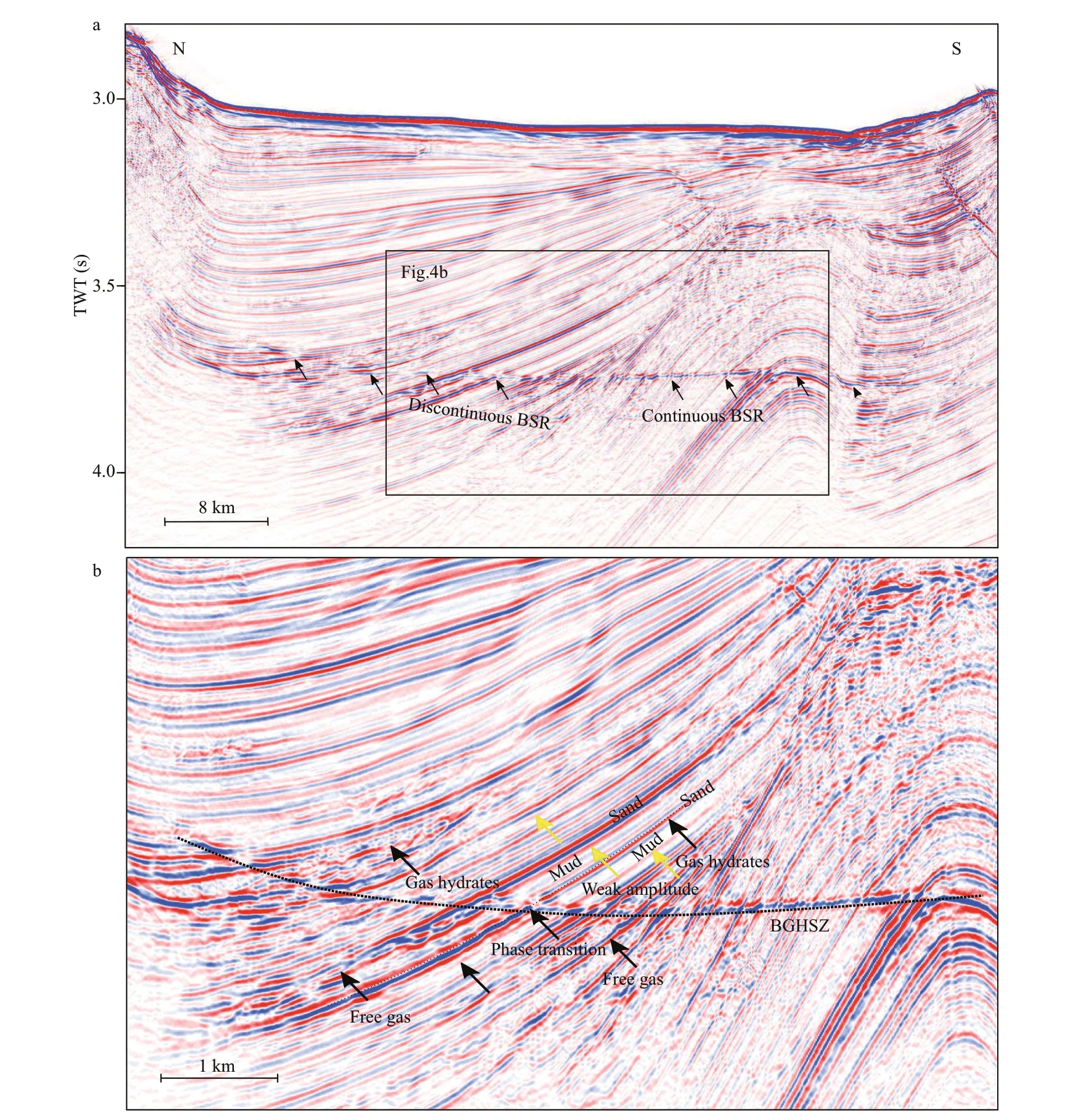
Fig.4 Seismic profiles showing discontinuous BSR (a) and its interpretation (b)
4.2 Double BSRs
The high-quality and high-resolution seismic data allow us to clearly identify double BSRs.Solid evidence of the presence of double BSRs have been interpreted at three sites (Figs.1,5–7).All the three double BSRs occur in the piggy-back basins.From Figs.5–7,we observe that both the shallow and the deeper BSRs have reversed polarity with respect to the seafloor reflection.However,the deeper BSRs have much weaker seismic amplitudes and poorer spatial continuity (Figs.5–7).
From the bathymetric data,all the three sites where double BSRs are interpreted are associated with submarine canyons (Figs.5a,6a,&7a).We designate the BSR parallel to the paleo-seafloor BSR1,and the one sub-parallel to the present seafloor BSR2.The presence of double BSR is associated with disrupted reflections,especially for the double BSR at seismic profiles 21 and 23 (line21 and line23 in Fig.1b).The disrupted reflections differ them from the otherwise normal piggy-back basin where slope sediments are deposited and folded progressively.In Fig.6,between the modern seafloor and the interpreted paleo-seafloor,the reflections are chaotic.In both Figs.5 &7,the BSR1 is shallower and BSR2 is deeper.While in Fig.6,BSR1 is deeper and BSR2 is shallower.
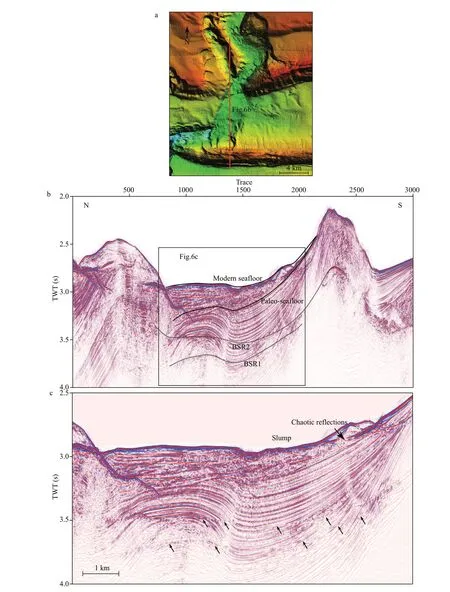
Fig.6 Double BSR observed on seismic profile 21 (line21 in Fig.1b)
4.3 BSRs in the abyssal plain
BSRs also occur in the abyssal plain where the water depth is greater than 4 s in two-way travel times(i.e.,over 3 000-m depth).To our knowledge,this represents the first discovery of BSRs in the abyssal plain in the Makran accretionary prism.The abyssal plain BSR has been observed in 5 of the 6 north-south seismic profiles (Fig.8).The BSRs,which are generally characterized by strong amplitudes mainly,occur on the flank and axis of anticline structures.Below them,strong-amplitude reflective formations can be interpreted associated with gas chimneys and fault structures,indicating the most likely fluid migration pathways.However,in some of these features of interest there are no obvious feeding pathways (Fig.8a–d).This interpretation is supported by seismic profile 22 (line22 in Fig.1b),where it is possible to observe a series of reflection-pull downs below the BSR (Fig.8e).Seismic profile 23 (line23 in Fig.1b) shows a fault that extends from the deep (near or below the basement) to a shallow and localized amplitude enhanced zone (Fig.8f).
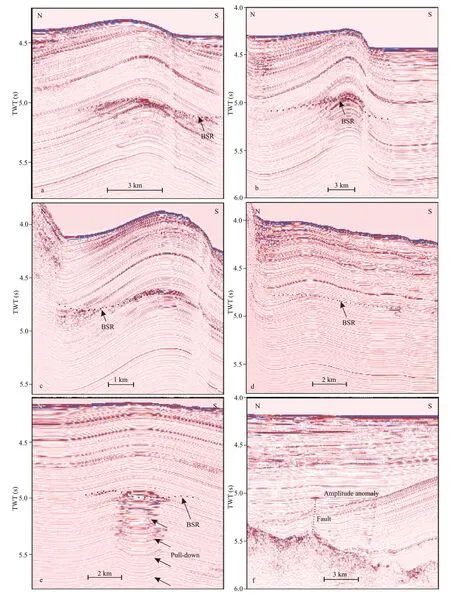
Fig.8 Characteristics of the BSR and associated fluid flow features in the abyssal plain
5 DISCUSSION
5.1 Phase transition,discontinuous BSRs,and their implications
Phase transition associated with discontinuous BSRs was firstly reported in the Gulf of Mexico(Shedd et al.,2012) and later in the Nankai Trough(Tamaki et al.,2017).Phase transition is characterized by the change of polarity of the event along a layer.This type of event across the BSR has been interpreted as a transition from a gas-rich segment to a gas hydrate-bearing segment along a high-permeability stratum both in the Gulf of Mexico (Shedd et al.,2012;Tamaki et al.,2017).Moreover,combined interpretations of seismic profile and drilling logs in the Gulf of Mexico have shown that phase transition directly corresponds to the change from free gas to gas hydrates in the sand layers and is associated with the alternating sediments of fine and relatively coarse grain size (Shedd et al.,2012).
At the Makran zone,we found clear phase transition zones as illustrated in Fig.4a.The interpretation of the seismic amplitude shows that the layers where continuous BSRs are located show relatively uniform weak amplitudes,which may indicate that the layers are under-compacted and highly permeable,while discontinuous BSRs are distributed in layers between strong and weak amplitudes,which may indicate alternating sandy and muddy formations.Moreover,previous studies have shown that most of the sediments in the piggy-back basins are sand-enriched(Fruehn et al.,1997).Based mainly on this type of similarity and the knowledge of sandy sediments,we also interpret the phase transition as an indicator of a transition from gas-rich sediments to gas-hydrate-rich sediments along the high-permeability layers (Fig.4b).According to this interpretation,free gas mainly migrates upwards along the highly permeable sandy layer and converts into gas hydrate after entering the gas hydrate stability zone.
The findings of hydrate-bearing sand have important implications for gas hydrate exploration and exploitation.After several decades of survey and many drilling programs,it is well known that gas hydrate potential is huge.However,the diffi culties associated with hydrate recovery vary from place to place,depending on several factors,such as the saturation,how it occurs within the sediments and the lithology of the host sediments.According to the pyramid mode proposed by Boswell and Collett(2011),the most promising target is gas-hydratebearing sands.The well-known and extensively studied gas-hydrate-bearing sands are located in the Nankai slope (Tamaki et al.,2017) and in the Gulf of Mexico (Boswell et al.,2012;Shedd et al.,2012).Hence,the possible accumulation of gas hydrates in the sand layers implies that gas hydrate accumulation is very promising at the submarine Makran subduction zone from the perspective of exploration and exploitation.In particular,the discontinuous BSRs of the Makran subduction zone indicate a potentially promising gas hydrate enrichment area.The sand layers within this area is an ideal gas hydrate exploration target and production,which act as continuous feeding pathways.Nevertheless,the saturation,gas source,and gas flux of gas hydrate formation in the subduction zone still need further evaluation.
5.2 Origin of double BSRs and its implication for gas hydrate system
As mentioned,double BSRs have been documented in many sites around the world.The presence of double BSRs is a puzzling phenomenon and the mechanism behind its origin is still a hot research topic.In former studies,alternative mechanisms have been proposed and can be summarized as follows:(1) the shallow BSR corresponds to the type I methane gas hydrate while the deeper BSR corresponds to the type Ⅱ gas hydrate (Geletti and Busetti,2011),(2) the multiple BSRs indicate the shift of gas hydrate stability zone in response to the temperature and/or pressure change due to the environment change(Foucher et al.,2002;Popescu et al.,2006),(3) multiple BSRs correspond to the top and base of the free gas zone (Tinivella and Giustiniani,2013) or gas hydrate zone (Posewang and Mienert,1999),(4) the deeper BSR is caused due to the over-pressure conditions below the theoretical gas hydrate stability zone (Tinivella and Giustiniani,2013),and (5) the diagenetic transition from opal A to opal CT (Berndt et al.,2004).
In Makran area,previous studies have proposed the probable presence of double BSRs (Ding et al.(2010).Based on the high-quality and highresolution of the recently acquired seismic profiles,we have clearly identified double BSRs at three sites.We infer that double BSRs at the three sites are formed due to localized geological events based on the following arguments:(1) the dominating gas in this basin is methane (Römer et al.,2012),so it is unlikely that double BSRs are formed due to the presence of different types of gas hydrates;(2) although seismic profiles cover a very large area,double BSRs are only found at three sites within very limited areas.Any regional factors that cause the shift of gas hydrate stability zone are unlikely;(3) we do not have any evidence to correlate multiple BSRs to transitions from opal A to opal CT.However,for all the three sites where double BSRs were interpreted,some chaotic seismic reflections are observed.Based on these close spatial correlations between the presence of double BSRs and the presence of chaotic seismic reflections,we infer that local geological events corresponding to the chaotic reflections may play a very important role in the formation of double BSRs.
Based on bathymetric data and the reflection characteristics,we infer that the possible geological events are associated with slumps (Figs.6 &7) or rapid sedimentation (Fig.5).Both slumps and rapid sedimentation events increase the formation pressure and change the spatial location of the gas hydrate stability zone.Once slump occurs,instantaneously,the pressure of sub-seafloor sediments increases due to the replacement of low-density water with highdensity material,while the thermal conditions require much more time to change.Though it takes more time for rapid sedimentation to increase the formation pressure,it may still be faster than the change of thermal conditions.Correspondingly,the effects of slump and rapid sedimentation on the gas hydrate stability may depend on how long the time has passed.We evaluate the effects considering two scenarios following Dickens and Quinby-Hunt (1994) Equation(Fig.9).The first scenario considers that the thermal condition has not changed (Fig.9a) and the second one that the thermal condition has changed long time after the slump occurred (Fig.9b).
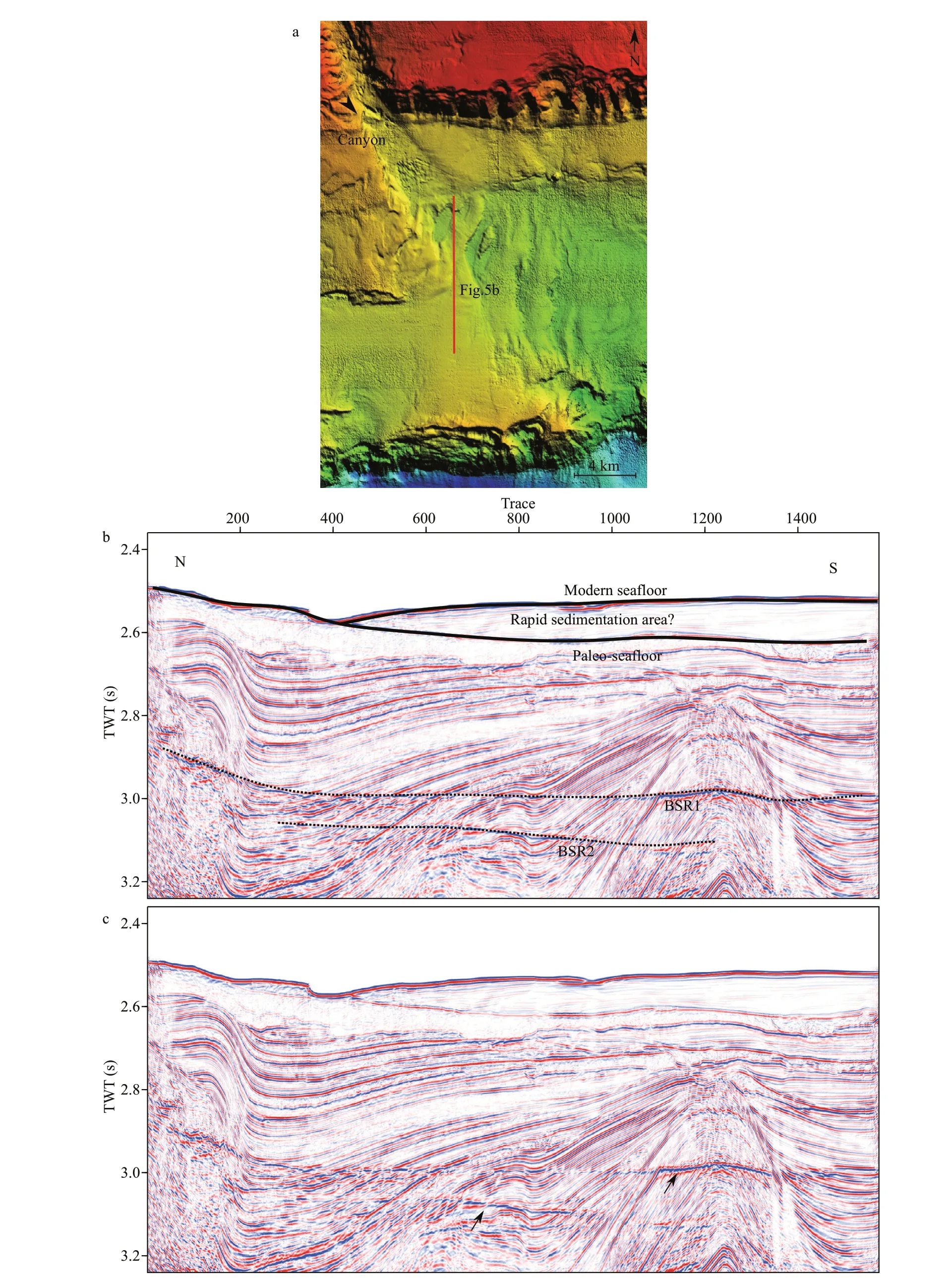
Fig.5 Double BSR observed on seismic profile 18 (line18 in Fig.1b)
For the first scenario,when thermal condition has not changed,according to the gas hydrate phase curve,the increase of the pressure will widen the temperature range,so the gas hydrate can develop and be stable in the deeper geological layers (Fig.9a).The deeper BSR corresponds to impedance contrast between the gas hydrate-bearing sediments and the underlying free-gas bearing sediments,while the shallower BSR corresponds to the impedance contrast caused by the higher concentration gas hydrate above and the relatively lower concentration gas hydrate below.This could be analogue to the case when double BSR is formed due to the occurrence of type II gas hydrate.The relatively lower concentration gas hydrate in the deeper sediments may be caused by limited water supply.In this case,the BSR parallel to the paleo-seafloor (BSR1) is shallower,and the BSR associated with the slump (BSR2) is deeper (Fig.9c).This mechanism can explain the observations of double BSRs in Fig.5 and Fig.7 where BSR1 is shallower than the BSR2.
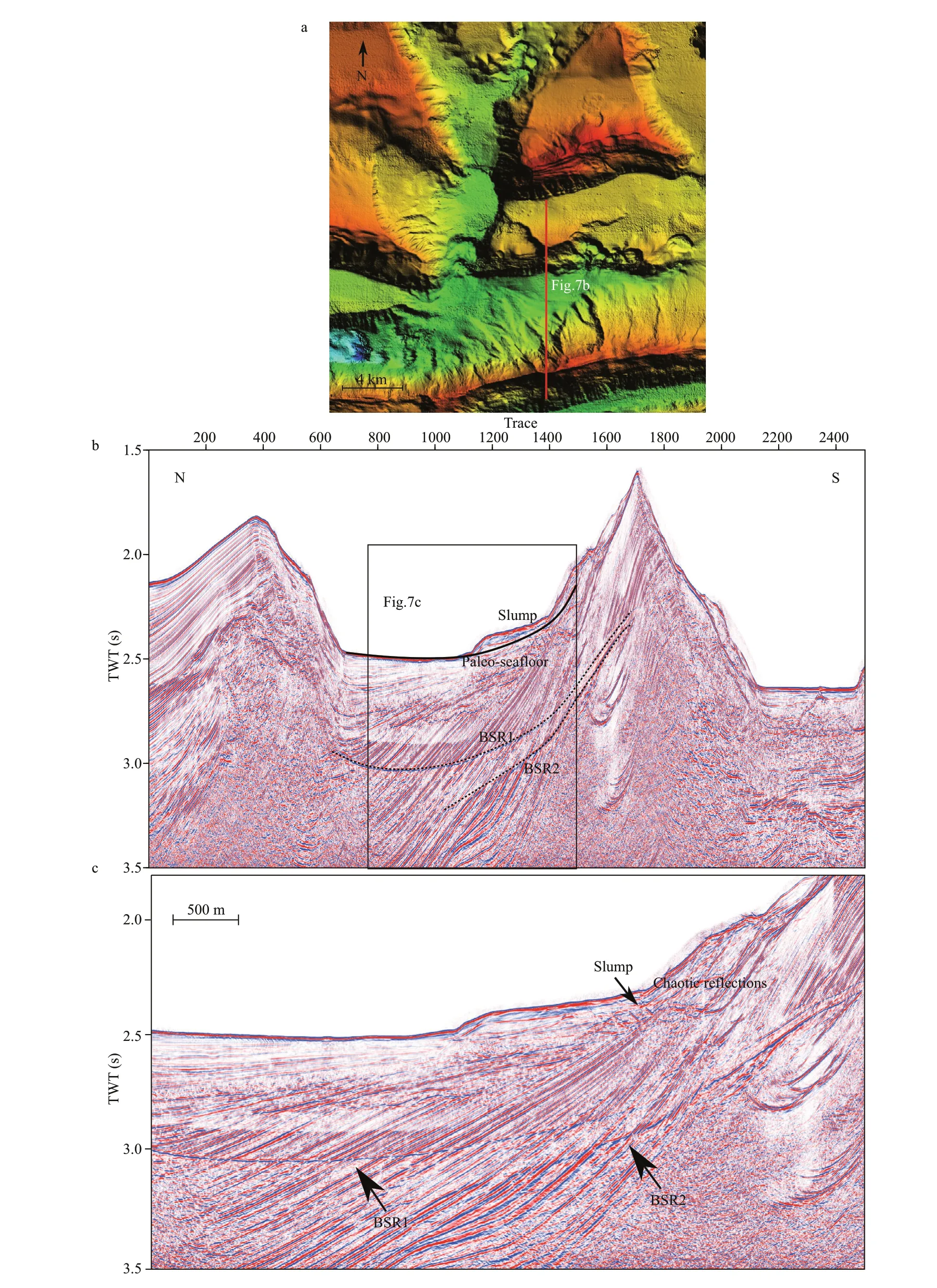
Fig.7 Double BSR observed on seismic profile 23 (line23 in Fig.1b)
For the second scenarios,when the thermal conditions have changed and a new steady state of the thermal structure has been achieved,the effect is very different.This effect is illustrated in Fig.9b,as time goes by,the depth-temperature curve may change from the solid line to the dashed line since a steady thermal state requires an almost constant thermal gradient parameter.As shown in Fig.9b,the temperature curve will cross the gas hydrate stability zone (GHSZ) curve at a shallower depth.Below this depth,the gas hydrate will be unstable and start to dissociate.In this case,the deeper BSR is a residual BSR and is parallel to the paleo-seafloor while the shallower BSR corresponds to the base of new GHSZ.As shown in Fig.9d,BSR1 is deeper than BSR2.This mechanism may explain the observations of double BSRs in Fig.6 where BSR2 is shallower than the BSR1.
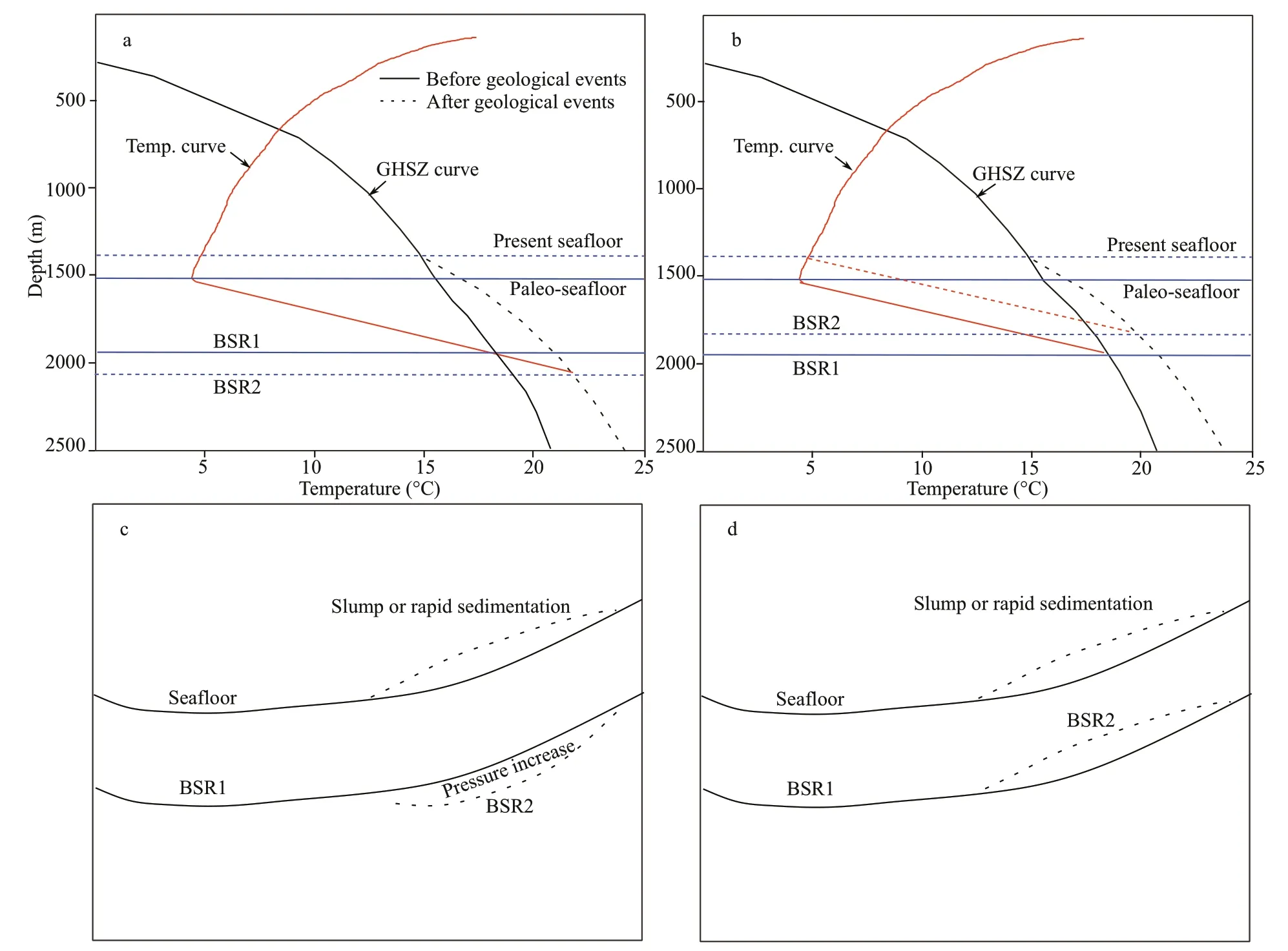
Fig.9 The effects of local geological events on the gas hydrate stability zone (a,b) and the corresponding seismic expressions (c,d)
Based on the discussion above,we can further speculate that geological events in Fig.5 and Fig.7 may occur recently and exert little influence on the thermal state,while in Fig.6 site,a long time may have passed since the slump and thermal structure has been changed.In this perspective,double BSRs may have important implications for studying geo-hazards such as slumps.Considering the correlation between the double BSRs and the slumps,when more detailed information is available,the slump mechanism and the onset time may be inferred,so that the interpretation of the slump will be combined with a detailed analysis of the double BSRs.As slump is a potential geohazard and is diffi cult to assess in the deep-water environment,studying slump using double BSRs may provide an alternative approach.This is of particular interest for the Makran area,as slumps are widespread due to the steep seafloor morphology,the high-rate sedimentation,and the subduction process.For this reason,we believe that the link between the double BSRs and the slumps need to be deeply analyzed using diverse data and methods.
5.3 Abyssal plain BSRs and their implications for gas hydrates
Aside from the suitable pressure and temperature conditions,the formation of gas hydrate requires a gas source.The abyssal plain is not expected to host gas hydrate since gas supply in the deep sea is expected to be low and not suffi cient to support the formation of gas hydrates.In the study area,active seepage is widespread on the continental slope (Von Rad et al.,1996,2000),indicating rich methane supply.On the abyssal plain,although mud volcanoes have been discovered,they are inactive (Wiedicke et al.,2001;Bohrmann et al.,2008).
BSRs are observed in the abyssal plain on several profiles (Fig.8a–e).We interpret them as gas hydrate accumulations mainly based on the character of BSRs.A large fault is clearly observed to extend from the basement to an amplitude enhanced zone.The BSRs mainly lie on the axis of anticlines,where gas can accumulate and be sealed in the structurally high area (Fig.8a–e).The strong amplitude below the hydrate layer indicates the presence of free gas,and the high permeability formation,which may be a sand layer,is the main channel for gas migration.Most of the BSRs are local,and there are no obvious feeding focused fluid pathways,indicating that the gas source may be more likely shallow biogenic gas.
However,in some cases,gas from deep sources migrates to shallow zones through faults and gas chimneys.Gas accumulation is strongly evidenced by the series of reflection-pull down beneath the BSRs associated with the top of gas chimneys (Fig.8e).A large fault is clearly observed to extend from the basement high to an amplitude enhanced zone(Fig.8f),we believe that fault acts as the fluid migration pathway and provides the gas needed by the gas hydrate formation.Even so,the BSR distribution in the abyssal plain is strictly restricted,indicating that the distribution of gas hydrates in the abyssal plain may not be extensive and is greatly controlled by local fluid pathways,including high permeable sand layers,faults,and gas chimneys.
6 CONCLUSION
High-resolution seismic data were acquired in the Makran area.BSRs were interpreted and are common on most of seismic profiles.Additional to the detailed mapping of these structures,the high-resolution seismic sections reveal some new characteristics of these seismic signatures allowing new insights to be drawn.
(1) BSRs are common on the continental slope and indicate the widespread accumulations of gas hydrates.The clear phase transition across the BSRs and along the same layer suggests that gas hydrates accumulate in high-permeability sandy layers,which would be very promising reservoirs from the exploration and exploitation perspectives.
(2) Clear and solid double BSRs are observed at three sites.All the double BSRs are spatially coincident with anomalous reflection or chaotic reflections.These reflections are interpreted to correspond to slumps or rapid sedimentation event.Double BSRs are believed to be a response to the pressure and temperature variations due to the local geological events.The close relationship between double BSRs and the slump processes makes it possible to assess the slump by studying the nature of double BSRs.The gas hydrate system is highly dynamic,and associated submarine geo-hazards need to be considered.
(3) BSRs in the abyssal plain are observed associated with the anticline structures of several sites.Permeable layers,faults,and gas chimneys act as pathways feeding natural gas hydrates formation.The discovery of abyssal plain BSR may help localize oil and gas reservoirs of the abyssal basin.
7 DATA AVAILABILITY STATEMENT
The datasets generated during and/or analyzed during the current study are available from the first and corresponding author on reasonable request.
8 ACKNOWLEDGMENT
Great thanks to the crew members and scientists that participated in acquiring geophysical data during the China-Pakistan joint marine scientific expedition.We thank Guangzhou Marine Geological Survey for their permission to publish the results.Figure 1a was generated with the GMT tools (Wessel and Lius,2017).
杂志排行
Journal of Oceanology and Limnology的其它文章
- Screening of stable internal reference genes by quantitative real-time PCR in humpback grouper Cromileptes altivelis*
- Morphology and multifractal features of a guyot in specific topographic vicinity in the Caroline Ridge,West Pacific*
- Geochemical characteristics and geological implication of ferromanganese crust from CM6 Seamount of the Caroline Ridge in the Western Pacific*
- Deep-sea coral evidence for dissolved mercury evolution in the deep North Pacific Ocean over the last 700 years*
- Physical oceanography of the Caroline M4 seamount in the tropical Western Pacific Ocean in summer 2017*
- Characteristics and biogeochemical effects of oxygen minimum zones in typical seamount areas,Tropical Western Pacific*
